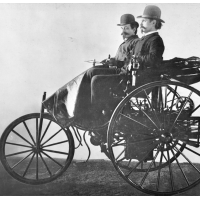DMV Puts Google Car Drivers Back Behind the Steering Wheel
 Cars, like the 1885 Benz Patent-Motorwagen, didn’t always have steering wheels
Cars, like the 1885 Benz Patent-Motorwagen, didn’t always have steering wheels
Google wants to build a car within five years that drivers won’t have to steer, brake or accelerate, but new California rules (pdf) that go into effect next month require the Mountain View company’s test vehicles to, at least temporarily, have all those little extras.
The state Department of Motor Vehicles (DMV) regulations require than any driver of an “autonomous vehicle” on public roads “is either in immediate physical control of the vehicle or is actively monitoring the vehicle’s operations and capable of taking over immediate physical control.”
That doesn’t prevent Google from testing the car on private property in California or taking the car out of state. But the Wall Street Journal reported that Google will simply tack on a steering wheel and pedals for the short-term.
Google’s testing will be limited to cars. The DMV reportedly decided earlier in the year that the company cannot test an autonomous motorcycle or truck on public roads under any circumstances.
Google plans to unloose a prototype autonomous car on private roads next month in preparation for public road testing by ordinary citizens in a few years. The company is building around 100 cars that will travel at a top speed of 25 mph.
The Journal quotes Claire Hughes Johnson, a top executive in the Google Self-Driving Car Project, as indicating that the Google car may have, at least, its initial impact as a service provider.
“What if you all got here today in a self-driving car that dropped you off and then left?” she asked the audience. “So you may not be able to buy one, but you may be able to drive in one in the next five years.”
Assuming the technology works and makes it through the government regulatory process, the breadth of the market for the service could depend on a range of pricing factors and synergies. If they prove to be safer, insurance rates could decline. If the car is small and stripped down, it could cost less to buy. If it’s electric, it’s cheap to operate.
Mark Rogowsky at Forbes figures “the least expensive private vehicles will be ones you don’t buy, you don’t drive and you don’t fuel with gasoline.”
Unless he was just talking to Forbes readers, for whom convenience may outweigh price considerations, that assumes all those savings result in a product cheap enough for the masses. That could take a while.
In the meantime, it might be a short gig for Uber drivers during the transition to the sharing economy and robots.
–Ken Broder
To Learn More:
A Google Car Without a Steering Wheel? Not So Fast, California Says (by Alistair Barr, Wall Street Journal)
California DMV to Google Self-Driving Car: Go, Get a Steering Wheel (by Nicole Arce, Tech Times)
California DMV Says Google’s Autonomous Car Tests Need a Steering Wheel (by Ron Amadeo, Ars Technica)
California Hits the Brakes on Google's Self-Driving Car (by Sarah Drake, San Francisco Business Journal)
Google Driverless Cars Slowed by California DMV Testing Laws (by Jeff Stone, International Business Times)
Robo-Cars, Uber Will Save Us Billions, Keep Us from Crashing and Put an End to Waiting at the DMV (by Mark Rogowsky, Forbes)
If a Driverless Car Gets a Ticket, Who Pays? (by Noel Brinkerhoff and Danny Biederman, AllGov California)
- Top Stories
- Controversies
- Where is the Money Going?
- California and the Nation
- Appointments and Resignations
- Unusual News
- Latest News
- California Forbids U.S. Immigration Agents from Pretending to be Police
- California Lawmakers Urged to Strip “Self-Dealing” Tax Board of Its Duties
- Big Oil’s Grip on California
- Santa Cruz Police See Homeland Security Betrayal in Use of Gang Roundup as Cover for Immigration Raid
- Oil Companies Face Deadline to Stop Polluting California Groundwater





